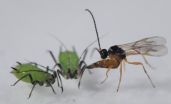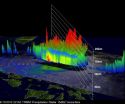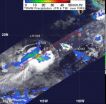(Press-News.org) When a carnivore becomes extinct, other predatory species could soon follow, according to new research. Scientists have previously put forward this theory, but a University of Exeter team has now carried out the first experiment to prove it.
Published today (15 August 2012) in the Royal Society journal Biology Letters, the study shows how the demise of one carnivore species can indirectly cause another to become extinct. The University of Exeter team believes any extinction can create a ripple effect across a food web, with far-reaching consequences for many other animals.
The research adds weight to growing evidence that a 'single species' approach to conservation, for example in fisheries management, is misguided. Instead the focus needs to be holistic, encompassing species across an entire ecosystem.
The researchers bred two species of parasitic wasps, along with the two types of aphids on which each wasp exclusively feeds. They set up tanks with different combinations of the species and observed them for eight weeks. In tanks that did not include the first species of wasp, the second went extinct within a few generations. In tanks in which they co-existed, both wasp species thrived.
In the absence of the first wasp species, its prey grew in numbers. This threatened the other aphid, which the second wasp species attacks, eventually leading to its extinction. Both types of aphids feed on the same plants and there was not enough food for one to survive when the other thrived in the absence of its wasp predator.
Lead researcher Dr Frank van Veen of the University of Exeter's Centre for Ecology and Conservation said: "Our experiment provides the first proof of something that biologists have argued for a long time: predators can have indirect effects on each other, to the extent that when one species is lost, the loss of these indirect effects can lead to further extinctions. Although our study focused on insects, the principle would be the same for predators in any ecosystem, ranging from big cats on the African plains to fish in our seas.
"Our research highlights the fact that a 'single species' approach to conservation can be ineffective and even counter-productive. For example, protecting cod could lead to increased fishing pressure on other predatory fish which then, by the mechanism we have demonstrated here, could lead to further negative effects on the cod."
The experiment was designed by a team of University of Exeter scientists and second-year undergraduate students. The idea came about during a seminar, in which students were challenged to design an experiment that could prove the theory that predators have indirect effects on each other. The students were so inspired by the idea of proving a long-held theory that more than 30 of them volunteered to conduct the experiment with their lecturers.
INFORMATION:
Study proves that 1 extinction leads to another
2012-08-15
ELSE PRESS RELEASES FROM THIS DATE:
Plants exhibit a wide range of mechanical properties, engineers find
2012-08-15
CAMBRIDGE, MA -- From an engineer's perspective, plants such as palm trees, bamboo, maples and even potatoes are examples of precise engineering on a microscopic scale. Like wooden beams reinforcing a house, cell walls make up the structural supports of all plants. Depending on how the cell walls are arranged, and what they are made of, a plant can be as flimsy as a reed, or as sturdy as an oak.
An MIT researcher has compiled data on the microstructures of a number of different plants, from apples and potatoes to willow and spruce trees, and has found that plants exhibit ...
How do they do it? Predictions are in for Arctic sea ice low point
2012-08-15
It's become a sport of sorts, predicting the low point of Arctic sea ice each year. Expert scientists with decades of experience do it but so do enthusiasts, whose guesses are gamely included in a monthly predictions roundup collected by Sea Ice Outlook, an effort supported by the U.S. government.
When averaged, the predictions have come in remarkably close to the mark in the past two years. But the low and high predictions are off by hundreds of thousands of square kilometers.
Researchers are working hard to improve their ability to more accurately predict how much ...
Girls with ADHD more prone to self-injury, suicide as they enter adulthood
2012-08-15
Girls with Attention Deficit Hyperactivity Disorder (ADHD) – and their families – often look forward to the likely decline in visible symptoms such as fidgety or disruptive behavior as they mature into young women.
However, new findings from UC Berkeley caution that, as they enter adulthood, girls with histories of ADHD are more prone to internalize their struggles and feelings of failure – a development that can manifest itself in self-injury and even attempted suicide.
"Like boys with ADHD, girls continue to have problems with academic achievement and relationships, ...
NASA sees more rain for the Philippines from Tropical Storm Kai-Tak
2012-08-15
An intensifying Tropical storm called Kai-Tak (locally known as Helen) is causing more rain in the Philippines as it passes over northern Luzon. The Philippines have had a very wet month with the capital of Manila experiencing massive flooding earlier this month. NASA's TRMM satellite identified where the heavy rain was falling.
Kai-tak has caused another day of warnings in the Philippines. On August 14, Public storm warning signal #1 is in effect for these provinces in Luzon: La Union, Nueva Ecija, Pangasinan, Rest of Aurora, and Tarlac.
In addition, Public storm warning ...
NASA's TRMM Satellite sees a small area of heavy rain left in Tropical Storm Hector
2012-08-15
Tropical Storm Hector is battling wind shear over the open waters of the Eastern Pacific Ocean, and NASA satellite data shows that has been affecting its organization and rainfall rates.
The Tropical Rainfall Measuring Mission satellite known as TRMM is managed by both NASA and the Japanese Space Agency. From its orbit in space, TRMM's instruments can estimate rainfall from tropical cyclones.
The TRMM satellite captured rainfall rates from Tropical Storm Hector on August 14, 2012 1:28 a.m. EDT. TRMM data showed that Hector had a small area of moderate to heavy rainfall ...
NASA seeing sprites
2012-08-15
VIDEO:
Filmed at 10,000 frames per second by Japan's NHK television, movies like this of electromagnetic bursts called "sprites " will help scientists better understand how weather high in the atmosphere relates...
Click here for more information.
High above the clouds during thunderstorms, some 50 miles above Earth a different kind of lightning dances. Bursts of red and blue light, known as "sprites," flash for a scant one thousandth of a second. They are often ...
Meditation reduces loneliness
2012-08-15
Many elderly people spend their last years alone. Spouses pass and children scatter. But being lonely is much more than a silent house and a lack of companionship. Over time, loneliness not only takes a toll on the psyche but can have a serious physical impact as well.
Feeling lonely has been linked to an increased risk of heart disease, Alzheimer's disease, depression and even premature death. Developing effective treatments to reduce loneliness in older adults is essential, but previous treatment efforts have had limited success.
What to do? Researchers at UCLA ...
Need an expert? Try the crowd
2012-08-15
In 1714, the British government held a contest. They offered a large cash prize to anyone who could solve the vexing "longitude problem" — how to determine a ship's east/west position on the open ocean — since none of their naval experts had been able to do so.
Lots of people gave it a try. One of them, a self-educated carpenter named John Harrison, invented the marine chronometer — a rugged and highly precise clock — that did the trick. For the first time, sailors could accurately determine their location at sea.
A centuries-old problem was solved. And, arguably, crowdsourcing ...
An artificial retina with the capacity to restore normal vision
2012-08-15
Two researchers at Weill Cornell Medical College have deciphered a mouse's retina's neural code and coupled this information to a novel prosthetic device to restore sight to blind mice. The researchers say they have also cracked the code for a monkey retina — which is essentially identical to that of a human —and hope to quickly design and test a device that blind humans can use.
The breakthrough, reported in the Proceedings of the National Academy of Sciences (PNAS), signals a remarkable advance in longstanding efforts to restore vision. Current prosthetics provide blind ...
Deep inside the body, tiny mechanical microscope
2012-08-15
Tiny space age probes — those that can see inside single living cells — are increasingly being used to diagnose illness in hard-to-reach areas of the body.
NewYork-Presbyterian Hospital/Weill Cornell Medical Center's Dr. Michel Kahaleh often threads a tiny microscope into the narrow bile ducts that connect the liver to the small intestine to hunt for cancer. He also uses the device to minutely explore the pancreatic duct as one of a few doctors in the country to use such technology in this way.
But because these devices are comparatively new, Dr. Kahaleh, chief of ...


